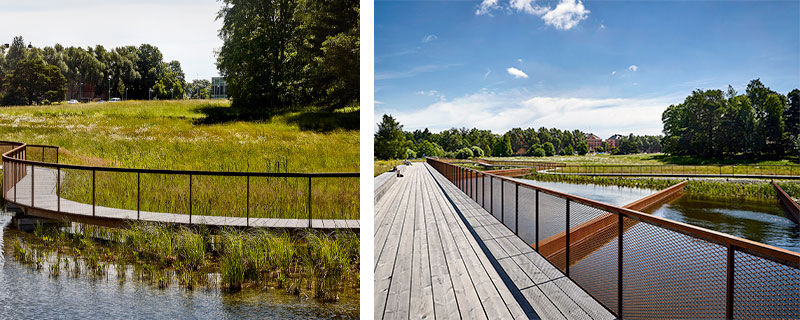Images: Måns Berg
In the southern Swedish city of Uppsala, stormwater pond Exercisfältet designed by Scandinavian firm White Arkitekter hopes “to protect nature from the city’s polluted water and to protect the city from flooding as a result of reduced infiltration and climate change.” The development is the result of an ambition to turn a technical facility into a place for people. A meandering bridge elevated above the pond situates a continuous south-facing seating for the public, whereas the curving stretch pulls those who cherish a serene walk along the water. The platform is also an incredible lookout spot for locals as it captures views of the urban habitation on one side, and water and vegetation on the other.
The project encapsulates climate resilience through a strong combination of infrastructure and landscape design. Keeping the city and its people’s well-being at the centre, White Arkitekter delivers a place of equal necessity and value in the urban scheme of things. With offices in Sweden, Denmark, Norway, and the UK, the firm’s portfolio covers sustainable architecture, urban design, landscape architecture, and interior design. The firm, with its ecological approach to the building art, upholds the vision of seeing all its architecture become carbon neutral by 2030 through design excellence. Wooden architecture, a specialisation of the firm, was recently seen in the design of a timber-framed office building in Gothenburg, a 20-storey timber hotel, museum and theatre in Skellefteå, and the upcoming Stockholm Wood City, conceived in collaboration with Henning Larsen.
The pond comes along as a technical requisite to the urban demands. “In the wake of the so-called Weser ruling by the European Court of Justice,” states White Arkitekter, “cities are being asked to clean dirty water from roads and houses before it is discharged into the environment.” The stormwater pond commissioned to the firm by Uppsala Municipality and Uppsala Vatten acts in response to this notion, in addition to reinforcing nature in its scheme and making it a people’s place to socialise and connect with their neighbourhood. “The fact that this was also to be done in a sensitive cultural environment made the task complex. It is very gratifying to see how people have now taken it to their hearts, a proof that we have succeeded,” says Charlotta Råsmark, lead landscape architect at White Arkitekter.
The pond creates an open-ended connection with its place. Around the facility, generous spaces and paths tread along the water, allowing the beauty of the landscape to spill farther. A robust flood protection system comes together in the form of a concrete wall barrier that follows the lines of the block division, and further features a sharp edge of the pond closer to the city. The location of the pond at a low-lying terrain ensures it renders a discreet presence without disturbing the landscape, its cultural and historical values, as per the architects.

The vegetation within and around the pond has been adapted to suit the natural features of the site. A series of species that are both hardy and have water purifying properties have been included in the landscape scheme. “The various parts of the pond are flooded by different amounts of rainfall and have great potential to develop into a good habitat for many different animals and plants,” White Arkitekter states. The architects anticipate that the development along the pond shall continue to evolve and move closer to the edge, ensuring more life and activity will engulf the space, realising the overarching ambition that drove the design. The pond, beyond its ecological goal, is conceptualised as an engaging interface that ties the urban habitation and open landscape. The stormwater pond also articulates the need of innovative landscape interventions in urban microcosms as nature harbingers and people-pullers.
Source: Stir





Leave a Reply
Want to join the discussion?Feel free to contribute!